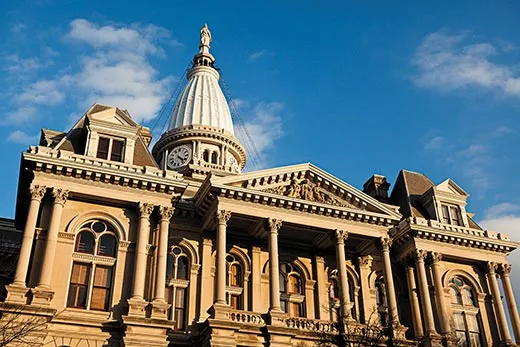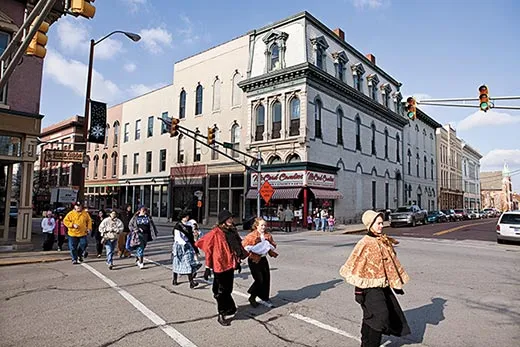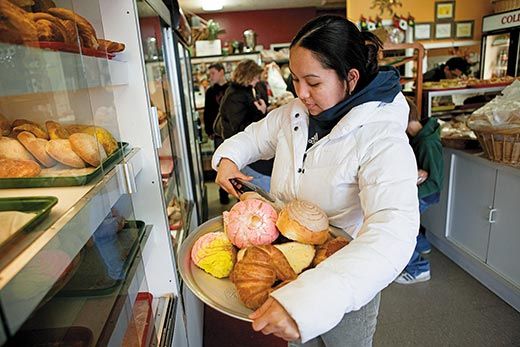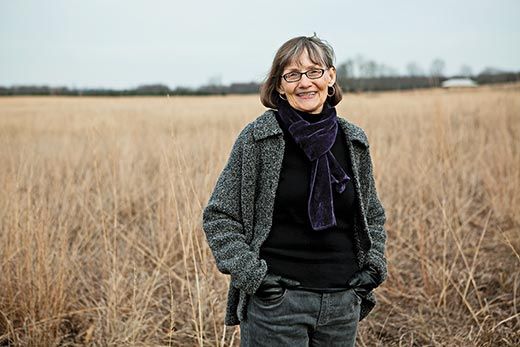Sticking Around Lafayette, Indiana
She didn’t plan on staying, but more than 20 years later novelist Patricia Henley embraces her adopted community
/https://tf-cmsv2-smithsonianmag-media.s3.amazonaws.com/filer/My-Kind-of-Town-Lafayette-Indiana-631.jpg)
I grew up on a back road in a stretch of flat farmland in west-central Indiana. When school was out, the summer bookmobile was my lifeline. It would park near the railroad trestle, in a half-moon of gravel, and I would load up on novels and feel secure, knowing that when chores were done and softball games over, I had a story to read. When I was 16, my parents moved us to Maryland. We drove through the curvaceous Appalachian Mountains. Ever after I have craved hills and mountains and travel, but I have almost always made my home in small towns or on back roads near small towns. I thought I would never go back to Indiana, yet after years of nomadic life, I did return, a little over two decades ago, and I stayed. I live in a 19th-century brick house on a half-acre surrounded by fields where coyotes howl. It’s similar to my life as a child. Stories are important to me, as well as meandering walks, gardening and observing what the philosopher David Abram calls the “more-than-human world,” the coyotes and herons, fir trees and coneflowers. Still, the phrase “going to town” has an anticipatory glimmer.
When I go to town now, it’s to Lafayette, Indiana.
I arrived here on a sweltering night in August 1987 in a Honda Civic I had driven from Montana, a red kayak strapped to the roof. I spent the last few hours on back roads, tunneling through corn. The towering fields seemed architectural, as if they would last forever. Insects crusted up on the windshield; every 30 miles or so I would clear them off with an ice scraper. Purdue University had offered me a stint as the visiting writer and I figured when it was over I would skedaddle back to the Rockies. I cruised right on through West Lafayette, the enormous hilltop campus of Purdue, crossed the Wabash River and drove up South Street, another hill, and that made me happy—I would not have to give up rolling terrain after all.
I was asked to stay on, and I did. For the first seven years, I lived on the Lafayette side of the Wabash in a furnished apartment. My office mate at Purdue was an Italian-American poet, Felix Stefanile, who had arrived from New York in 1961. Felix would listen to my whining about the lack of espresso, no café life. “When I moved here,” he would admonish me, grinning, “you couldn’t find an Italian tomato in the grocery.” That made sense, sadly; my mother’s repertoire of vegetables had ranged from corn to green beans and back again. Perhaps because of my Catholic upbringing and all the rules it imposed, I rolled back into my home state expecting it to be repressed and unimaginative, but I discovered its secret underbelly. I found it in candlelit solstice ceremonies and at the Depot, a gay bar, where, beneath a sparkly disco ball, drag queens danced joyously in prom gowns that would have made a sorority sister proud. I have no idea if such alternatives persist; my life is different now.
Back then I had one foot out the door, my suitcases at the ready. I resisted being here. Tongue-in-cheek, I called it La Fiesta or Lay Flat, like many who want to leave but can’t work up what one of my friends calls escape velocity. And what escapes did I want? My desires varied from the jazz clubs of San Francisco to the desert in bloom. The conventional wisdom among some Indiana writers is that we are always trying to decide whether to go or stay. My attitude precisely for the first ten years.
Even though I work on the west side of the Wabash, on a campus that is a small town in itself, with some 40,000 students, 10 Nobel Prize winners and 22 astronauts to its name, when the teaching day ends, I gravitate to downtown Lafayette. If I stand at one end of Main Street and squint, I can imagine it 50 years ago; the buildings from the 1800s have been preserved, the stone corbels and pointed-arched windows.
Old-timers may say that downtown isn’t what it once was, before the mall and the commercial strip that stretches for miles on Route 52. Downtown, you can’t buy a pound of nails or a new pair of shoes. But here’s what you can do: sip that espresso; buy locally made stained glass, earrings and cut-velvet scarves; drink oatmeal stout brewed in a former furniture store; select handmade chocolates for your sweetheart; hear a poetry reading or the Lafayette Symphony; buy antiques for a song; pick up a 13-mile trail that leads to the Tippecanoe Battlefield in Battle Ground; or attend a musical event put on by Friends of Bob, our local nonprofit music co-op. Downtown Lafayette hosts a farmer’s market that has operated in the same vicinity for 170 years. While the downtown of yesteryear—with its five-and-dime and movie theaters, its department stores and the red neon rocking chair atop Reifer’s Furniture—may be gone, the community still thrives here.
Of course, I noticed how friends and family reacted to my decision to live in Indiana. Until 2006 most of the state did not cotton to daylight saving time. We were on the same time as New York in the winter and Chicago in the summer. We never changed our clocks. This was confusing to friends who would telephone from other parts of the country. I would say: “In Indiana we never change.” One time a writer at a conference in Washington State dismissed me with a wave of her hand and said, “Oh, you’re from one of those I-states”—Indiana, Illinois, Iowa. As my grandmother would have said, she ruffled my feathers, and I never forgot it. I would invite friends and relatives to visit me in Lafayette, and they might hesitate, suggesting it was too flat or lacking in diversity, not a “destination,” as one cousin put it.
Not gussied up or cute, Lafayette is a sturdy town, persistent in its character, as I see it now, creative and practical, and it’s not true that we never change. Sleek condos branch out in the second and third floors of historic buildings downtown. A campaign is underway to clean up what unites both communities, the Wabash River. Walking and biking trails have been constructed, an annual River Fest established. A state-of-the-art homeless shelter was built by the Lafayette Urban Ministry, a coalition of 42 congregations from both sides of the river.
When it comes to diversity, Purdue has the second-highest number of international students among public universities and colleges in the country; the Subaru plant draws a Japanese community. I like to take visitors to Mama Ines Mexican Bakery. You can purchase sugar horns and marranitos—spicy, brown, pig-shaped cookies—in a store reminiscent of bakeries south of the border; with an aluminum tray and tongs, you help yourself from the pastry-laden cookie sheets, Mexican pop music blasting. An annual fiddlers’ gathering is held seven miles away and members of the rock band Green Day have done production work at Sonic Iguana, a renowned punk rock studio. We have more than 16 houses of worship downtown and I defy you to sleep through the Sunday morning bells. And the Dalai Lama spoke at Purdue in 2007. That’s diversity.
After living out of state for a year, Indiana essayist Scott Russell Sanders wrote: “What I see is stitched through and through with my own past.” I get his meaning now. Every time I’m near Riehle Plaza and the train depot, what crosses my mind is the annual Hunger Hike that starts there, raising money for local food banks and pantries. My muscles recall the jog I did for seven years, up the Columbia Street hill and down Union, rain or shine or snow. And farther afield are the places that have wormed their way into my fiction: the round barns of Fulton County and the prairie gardens of Prophetstown State Park.
Is all that nostalgia? I think not. The Tippecanoe County Courthouse, the centerpiece of downtown Lafayette, was built in the 1880s because the citizenry wanted a building of permanent and durable character. Made of Indiana limestone and brick, it has 500-pound walnut doors, 100 columns and Tecumseh himself rises from one of the pediments. The feeling that what I see is stitched through with my past is not nostalgia, but continuity. Like the courthouse, it makes for a durable, or grounded, life.
Living here is a little like marriage. There are limitations and a universe of satisfactions within them. I have developed a loyalty to what is. Yet I would be remiss if I did not acknowledge the role the Internet plays in my willingness to be content. It is the bookmobile of now. If wanderlust becomes an itch I have to scratch, it’s easy to purchase theater tickets for a week in London. I can order DVDs of Australian movies. But I walk a long gravel lane to retrieve my snail mail, the same as I did 50 years ago. When he was 3 years old, my youngest grandchild began walking with me to the mailbox. The first time we passed the row of dark blue-green conifers he said, “We’re in the woods now,” his voice hushed with awe and perhaps a little worry. The woods were still a mystery to him, just as they were to me as a girl. Some things have yet to change. Some things I hope never will.
Patricia Henley is the author of In the River Sweet, a novel set in the Midwest and Vietnam.
Planning Your Next Trip?
Explore great travel deals
Smithsonian magazine participates in affiliate link advertising programs. If you purchase an item through these links, we receive a commission.



